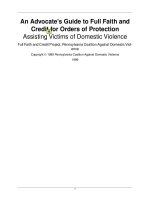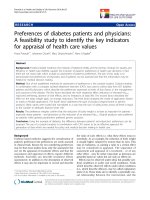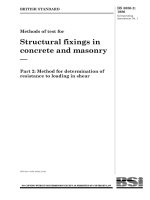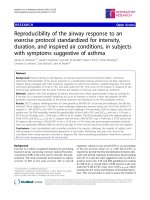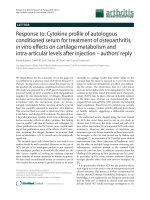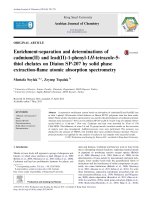Vortex-assisted ionic liquid microextraction coupled to flame atomic absorption spectrometry for determination of trace levels of cadmium in real samples
Bạn đang xem bản rút gọn của tài liệu. Xem và tải ngay bản đầy đủ của tài liệu tại đây (466.78 KB, 7 trang )
Journal of Advanced Research (2013) 4, 35–41
Cairo University
Journal of Advanced Research
ORIGINAL ARTICLE
Vortex-assisted ionic liquid microextraction coupled
to flame atomic absorption spectrometry for
determination of trace levels of cadmium in real samples
Mahmoud Chamsaz a, Atefe Atarodi a, Mohammad Eftekhari
Saeid Asadpour a, Mina Adibi b
a,*
,
a
Department of Chemistry, Faculty of Sciences, Ferdowsi University of Mashhad, Mashhad, Iran
Department of Specialty Chemical, Division of Chemical and Petrochemical, Research Institute of Petroleum Industry (RIPI),
Tehran, Iran
b
Received 26 September 2011; revised 18 December 2011; accepted 19 December 2011
Available online 14 January 2012
KEYWORDS
Microextraction;
Ionic liquid;
Preconcentration;
Oxine;
Cadmium;
Flame atomic absorption
spectrometry
Abstract A simple and rapid vortex assisted ionic liquid based liquid–liquid microextraction technique (VALLME) was proposed for preconcentration of trace levels of cadmium. According to this
method, the extraction solvent was dispersed into the aqueous samples by the assistance of vortex
agitator. Cadmium preconcentration was mediated by chelation with the 8-hydroxyquinoline
(oxine) reagent and an IL, 1-octyl-3-methylimidazolium hexafluorophosphate ([Omim][PF6]) was
chosen as the extraction solvent to extract the hydrophobic complex. Several variables such as sample pH, concentration of oxine, volume of [Omim][PF6] and extraction time were investigated in
details and optimum conditions were selected. Under the optimum conditions, the limit of detection
(LOD) was 2.9 lg LÀ1 for Cd () and relative standard deviation (RSD%) for five replicate determinations of 125 lg LÀ1 was 4.1%. The method was successfully applied to the determination of cadmium in tap water, apple and rice samples.
ª 2012 Cairo University. Production and hosting by Elsevier B.V. All rights reserved.
* Corresponding author. Tel.: +98 511 8795162; fax: +98 511
8796416.
E-mail address: (M. Eftekhari).
2090-1232 ª 2012 Cairo University. Production and hosting by
Elsevier B.V. All rights reserved.
Peer review under responsibility of Cairo University.
doi:10.1016/j.jare.2011.12.002
Production and hosting by Elsevier
Introduction
Environmental pollution nature of heavy metals has recently
received considerable attention. Cadmium is one of the heavy
metals which is critical for the human health [1,2]. It enters the
organism primarily via the alimentary and/or respiratory tract
[3] and, due to its low excretion rate (biological half-life of 10–
30 years), is accumulated in the body [4]. Jarup and coworkers
found that bone density dropped as Cd levels rose. These bone
density and fracture phenomena support the hypothesis of a
negative relationship between Cd body burden and in vivo
36
Ca levels [5]. Also, cadmium may lead to renal toxicity, pancreatic cancer, or enhanced tumor growth. Schwartz and Reis explained the Cd’s role in the development of pancreatic cancer
[1,2].
Cadmium is widely used in industry, especially in electroplating, pigments for paints, enamel, glass, plastics, printing
inks, rubber and lacquers, alloys and in the production of
Ni–Cd batteries [6,7]. Food and cigarette smoke are the main
sources of cadmium population. There are indications that the
occurrence of this metal in food stuffs has increased as a result
of contamination of the environment. The FAO/WHO Joint
Expert Committee on Food Additives recommended provisional maximum tolerable daily intake of cadmium from all
sources (food, air, and water) in the range of 1.0–1.2 lg kgÀ1
mass of body [8].
Therefore determination of trace amounts of cadmium in
environmental samples is of great importance. Different analytical techniques have been performed to determine cadmium
in various samples including flame atomic absorption spectrometry (FAAS) [9–11], graphite furnace atomic absorption
spectrometry (GFAAS) [12,13], inductively coupled plasma
emission spectrometry (ICP-OES) [14,15], inductively coupled
plasma mass spectrometry (ICP-MS) [16].
Flame atomic absorption spectrometry (FAAS) has been
widely used for determination of trace quantities of cadmium
because of the low costs, operational facility and high sample
throughput. However, conventional FAAS has a detection
limit, which is not low enough to determine cadmium at trace
levels. In order to achieve accurate, sensitive and reliable results at trace levels; preconcentration and separation steps
are needed prior to analyte determination by FAAS.
Several procedures such as liquid–liquid microextraction
(LLME) [17], solid phase extraction [18], coprecipitation [19],
and cloud point extraction [20–22] have been developed for
separation and preconcentration of cadmium from different
matrices. However, these methods often require large amounts
of organic solvents, some of which are harmful and contaminate the environment due to their high vapor pressure.
Room temperature ionic liquid (RTIL) is a kind of burgeoning green solvent. RTILs are liquid over a wide temperature range including room temperature and exist as a
combination of organic cations with various anions. Recently
RTILs with unique properties such as negligible vapor pressure, water stability, favorable viscosity and density characteristics, good thermal stability, non-volatility and good selective
solubility have been used as alternative solvents separation
purposes [23]. Several extraction methods have been reported
based on ionic liquids, such as ionic liquid-based headspace liquid phase microextraction [24], ionic liquid-based single-drop
microextraction [25,26], ionic liquid-based headspace singledrop microextraction [27], cold induced aggregation microextraction [28] and temperature-controlled ionic liquid dispersive
liquid phase [29]. Compared to conventional organic solvents,
in both direct-immersion and headspace LPME, a larger volume drop of ionic liquids can be suspended and it survives
for a longer extraction time in the tip of a microsyringe. Therefore, higher enrichment factor can be reached.
Recently a novel modality of liquid-phase microextraction
(LPME) technique based on a ternary component solvent
system as an alternative high-performance and powerful
M. Chamsaz et al.
preconcentration method termed dispersive liquid–liquid
microextraction (DLLME) has been introduced, which is simple, very fast and inexpensive [30]. But the amount of disperser
solvent used is relatively high, so it is possible that the partition
coefficient of the analytes into the extractant phase decreases.
So, several methods have been introduced to eliminate the disperser solvents [29,31,32].
In this work, we used vortex assisted ionic liquid based – liquid liquid microextraction (IL – based VALLME) method
coupled to flame atomic absorption spectrometry (FAAS)
for preconcentration and determination of trace levels of cadmium. Cadmium preconcentration was mediated by chelation
with the 8-hydroxyquinoline (oxine) reagent, followed by
extraction with the 1-octyl-3-methylimidazolium hexafluorophosphate ([Omim][PF6]) as RTIL. With shaking the solution
with vortex agitator at 2800 rpm (maximum setting), a vigorous vortex stream is formed in the whole of centrifuge tube
which cause very fine droplets of ionic liquid is produced. It
is revealed that after formation of fine droplets, the surface
area between extraction solvent and aqueous phase (sample)
is large. Therefore, The cadmium – oxine complex is extracted
into extractant phase ([Omim][PF6]) at short time.
Experimental
Instrumentation
A Shimadzu AA-670 (Shimadzu, Japan) flame atomic absorption spectrometer equipped with a 100 mm burner head, deuterium background correction and an air–acetylene flame
was utilized. A cadmium hollow-cathode lamp (Hamamatsu
Photonics, Shizuoka, Japan) at a wavelength of 228.8 nm
was used as a radiation source, operated at 4 mA with a monochromator spectral bandpass of 0.3 nm.
The pH values were measured with a pH-meter (Metrohm
632, Switzerland) supplied with a glass-combined electrode.
A vortex Gilson mixer (Villiers Le Bel, France) was used for
thorough mixing of solutions. Phase separation was assisted
using Centurion Scientific Centrifuge (Model Andreas Hettich
D72, Tuttlingen, Germany).
Reagents
All reagents were of analytical reagent grade and deionized
water was used throughout. A stock solution of 1000 mg LÀ1
cadmium (II) ion was prepared by dissolving the appropriate
amounts of cadmium chloride (Merck, Darmstadt, Germany)
in 1% HNO3. Working standard solutions were prepared
freshly at various concentrations by diluting the stock standard
solution with deionized water. SuprapurÒ HNO3 (65%),
H2SO4 (98%) and H2O2 (30%) were used for sample digestion.
The chelating agent, 8-hydroxyquinoline (oxine), was purchased from Merck. A solution of 10À2 mol LÀ1 oxine was prepared by dissolving appropriate amounts of this reagent in
0.1 mol LÀ1 acetic acid and diluting to 50 mL with deionized
water. 1-Octyl-3-methyl imidazolium hexafluorophosphate
([Omim][PF6]) was employed as the extractant solvent diluted
in ethanol after synthesis. The pH adjustment was made with
a 0.1 mol LÀ1 hydrochloric acid (for acidic pH values) or sodium hydroxide solution (for basic pH values).
Vortex-assisted ionic liquid microextraction for determination of cadmium
Preparation of real samples
– Water sample including tap water was collected from local
sources. Seven milliliter of sample solution was used for the
analysis after addition of 8-hydroxyquinoline (oxine) and
adjusting their pH to 11, with NaOH solution.
– Fifty gram of powdered Pakistan rice sample was purchased from a local supermarket in Mashhad, Iran. Dissolved in 150 mL concentrated HNO3 and heated on a
hot plate at a low temperature. Then, 50 mL of concentrated HCl was added to the mixture and heated to near
dryness. Under the heating conditions, concentrated hydrogen peroxide was added and heated for another hour to
complete the digestion. The solution was diluted to
100 mL with deionized water. Seven milliliter of this solution was analyzed according to the analytical procedure.
– Ten gram red apple sample (Neyshabur, Iran) and 40 mL of
concentrated HNO3 was heated on a hot plate at a fairly
low temperature in the glass beaker to dryness. After that,
25 mL of concentrated HCl was added and the heating
was repeated to near dryness. Under the heating conditions,
concentrated hydrogen peroxide was added and heated to
complete the digestion. After cooling down the resulting
solution to room temperature and dilution to 50 mL with
deionized water, 7 mL of this solution was analyzed according to analytical procedure.
– A 0.1 g of ERMÒ-ER325, certified reference material was
dissolved in 20 mL of 3 mol LÀ1 HNO3. The solution
heated to near dryness and diluted to 100 mL with deionized water. The cadmium content was determined according
to analytical procedure.
Synthesis of IL
To a solution of 20.6 g of [Omim][Cl] dissolved in 40 mL distilled water, was added 18.2 g of KPF6 dissolved in 25 mL distilled water and the mixture was stirred for about 5.5 h at room
temperature. A two phase mixture was formed. After leaving
the mixture for 30 min, the aqueous phase was separated from
the organic phase. The aqueous phase was then washed two
times with dichloromethane, each time with 50 mL. The combined organic phase was then added to the IL phase. The organic phase was washed three times with distilled water, each
time with 50 mL and was dried over magnesium sulfate. The
suspension was filtered and its solvent was evaporated. The final product was dried completely at 70 °C under vacuum to
give 27 g of product with 90% yield. [Omim][PF6] 1H NMR
(300 MHz; CDCl3): d (ppm): 0.88(3H, t), 1.28 (10H, m),
1.87(2H, t), 3.91(3H, s), 4.14(2H, t), 7.32(1H, s), 7.34 (1H, s),
8.46(1H, s) [33].
37
droplets of ionic liquid is formed through the solution and
the cadmium – oxine complex, was extracted into the fine
droplets of [Omim][PF6] at short time. In order to accelerate
phase separation, the solution was centrifuged for 5 min at
4000 rpm.
After this step, The IL-phase settled at the bottom of the
tube. The aqueous phase was discarded with syringe and the
IL phase was diluted to 500 lL using ethanol and was aspirated to flame atomic absorption spectrometry (FAAS) for
determination of cadmium.
Results and discussion
There are different factors that affect the extraction process
such as pH, concentration of chelating agent, amounts of IL,
extraction time and interfering ions. It is very important to
optimize these parameters in order to obtain high recovery
and enrichment factor.
Effect of pH
pH Plays a unique role on metal–chelate formation and subsequent extraction. In order to evaluate the effect of pH on the
extraction efficiency of Cd2+, the pH values of sample solutions was studied in the range of 5–13 and the results are
shown in Fig. 1. According to the results, the absorbance
was nearly constant in the pH range of 10–13 for cadmium
and hence, pH 11 was chosen as the optimum value.
Effect of oxine concentration
The extraction efficiency depends on the hydrophobicity of the
ligand that influence the hydrophobicity of the complex, the
kinetics of the chelate formation, the apparent equilibrium
constants in the ionic liquid medium, and the partition coefficients. In this work, 8-hydroxyquinoline (oxine) was used as
the chelating agent due to the highly hydrophobic nature of
its metal chelates. Concentration of chelating agent is a critical
variable and, it is highly important to establish the minimal reagent concentration that leads to total complex formation
while achieving the highest extraction.
The effect of concentration of oxine was investigated in the
range of 9 · 10À6–3.6 · 10À4 mol LÀ1. The results are given in
Microextraction procedure
Twenty-five milliliter of aqueous sample solution containing
100 lg LÀ1 Cd2+ and 1.35 · 10À4 mol LÀ1 of oxine, at pH
11, was prepared. 7 ml of this solution was transferred into a
conical-bottom glass centrifuge tube and 60 lL of [Omim][PF6]
ionic liquid (diluted in ethanol) was added to the mixture. The
resulting solution was vigorously shaken with vortex agitator
for 6 min at 2800 rpm. With shaking the solution very fine
Fig. 1 Effect of pH on the recovery of cadmium. Conditions:
100 lg LÀ1 Cd2+, 2.7 · 10À4 mol LÀ1 of oxine, 70 lL
([Omim][PF6]), extraction time 6 min.
38
Fig. 2 Effect of oxine concentration on the recovery factor.
Conditions: pH:11, 100 lg LÀ1 Cd2+, 70 lL ([Omim][PF6]),
extraction time 6 min.
Fig. 2, and show that the absorbance increased by increasing
the oxine concentration up to 1.35 · 10À4 mol LÀ1 and then remained constant afterwards. A concentration of 1.35 · 10À4
mol LÀ1 of oxine was chosen for subsequent determinations.
Effect of amounts of [Omim][PF6]
The amount of [Omim][PF6] used in preconcentration procedure is a critical factor for obtaining high recovery. Therefore,
the extraction system was carefully studied in order to define
the lowest IL-phase volume necessary for achieving the highest
recovery. The volume of [Omim][PF6] was studied in the range
of 20–80 lL. As can be seen in Fig. 3, by increasing the volume
of [Omim][PF6], the absorbance increased up to 70 lL and
then decreased by increasing the acceptor phase volume. By
increasing the volume of acceptor phase (IL), the viscosity of
settled phase increases and hence, the nebulization process is
not effective and therefore the absorbance decreases. Thus,
60 lL of ([Omim][PF6]) was employed as the optimum value.
Effect of the extraction time
Optimal extraction time is necessary in order to achieve
equilibrium. This is the minimum time necessary to achieve
equilibrium between the aqueous and the extractant phase to
obtain high sensitivity. The influence of the extraction time
Fig. 3 Effect of amounts of RTIL on the recovery factor.
Conditions: pH:11, 100 lg LÀ1 Cd2+, 1.35 · 10À4 mol LÀ1 of
oxine, extraction time 6 min.
M. Chamsaz et al.
Fig. 4 Effect of extraction time on the recovery factor. Conditions: pH:11, 100 lg LÀ1 Cd2+, 1.35 · 10À4 mol LÀ1 of oxine,
60 lL ([Omim][PF6]).
was evaluated in the range of 2–10 min at the constant experimental conditions. The results in Fig. 4, show that the signal
intensity increased by increasing the extraction time up to
6 min and then remained constant up to 10 min. Therefore,
in order to achieve a high enrichment factor; the extraction
time of 6 min was chosen as the optimum value.
Effect of centrifuge conditions
The effect of centrifugation rate on the absorbance was studied
in the range of 1000–5000 rpm. It was found that over
4000 rpm, IL phase completely settled, so that the rate of
4000 rpm was selected as optimum point. At the optimum rate,
absorbance was studied as a function of centrifugation time.
Five minutes was selected as optimum centrifugation time, because complete separation occurred at this time.
Effect of ionic strength
In general, the addition of salt plays an important role in
conventional extraction process. Various experiments were
Table 1 Effect of diverse ions on the determination of
100 lg LÀ1 of cadmium.
Coexisting ions
Molar ratio (ion/cadmium)
Recovery (%)
ClÀ
2À
CO2À
3 ; C2 O4
À
;
NO
PO3À
4
3
À
SO2À
4 ; CH3 COO
+
Na
K+
Co2+
Cr3+, Mn2+
Mg2+
Ca2+
Ba2+
Pb2+
Fe2+
Zn2+
Cu2+
Ni2+
3000
2000
1800
1000
4000
3000
2000
1800
1500
1500
1000
50
20
10
10
10
99
97.5
98.4
97.5
101.8
97.3
98
96
96.5
97.2
96.7
98.3
96
96
96.8
97
Vortex-assisted ionic liquid microextraction for determination of cadmium
Table 2 Results (mean ± standard deviation based on three
replicate analysis) of determination of cadmium in real sample.
Spiked (ng mLÀ1) Found (ng mLÀ1) Recovery (%)
Sample
b
Tap water
0
30
50
NDa
31.7 ± 0.5
51.7 ± 0.7
–
106
103
Rice sample
0
50
70
15 ± 0.4
57 ± 0.9
79 ± 1.5
–
88
93
Apple sample
0
70
ND
71.5 ± 1.3
–
102.4
39
variation of more than 5% in the absorbance of the sample.
The results are shown in Table 1. As it is shown, some of
the species tested, such as Cu2+, Zn2+, Fe3+ and Ni2+ did
interfere. The interfering effects of these ions can be eliminated
by using 0.02 mol LÀ1 of SCNÀ for Fe3+ ions and
0.01 mol LÀ1 of ascorbic acid and 0.01 mol LÀ1 of KI for
Ni2+ ions, the Zn2+ and Cu2+ interferences were eliminated
in the presence of 0.01 mol LÀ1 ascorbic acid and 0.01 mol LÀ1
1,10-phenanthroline.
Analytical figures of merit
performed by adding different amounts of KCl (0–1 mol LÀ1),
while the other parameters were kept constant. The obtained
results showed that the salt addition had no significant effect
on the extraction of the proposed method. Hence, all the
extraction experiments were performed without the addition
of salt.
Above 90% extraction was achieved for cadmium when the
procedure was performed under the optimal experimental conditions. The calibration graph was linear between 10 and
250 lg LÀ1 with a correlation coefficient of 0.9960. The regression equation after the preconcentration procedure was
A ¼ 0:0035CðCd2þ Þ À 0:001, where A is absorbance and C(Cd)
is cadmium concentration in lg LÀ1. Also the equation of
the calibration curve before the preconcentration procedure
was A ¼ 0:0001CðCd2þ Þ þ 0:021 within a dynamic range from
100 to 2000 lg LÀ1.
The detection limit based on three times of the standard
deviation of the blank signals (n = 8) was 2.9 lg LÀ1. The
relative standard deviation (RSD) resulting from the analysis
of five replicate solution containing 125 lg LÀ1 Cd2+ was
4.1%. Enrichment factor, calculated as the ratio between
the volume of the aqueous phase (7 mL) and the final volume of the IL-phase (500 lL), was 14 times. The enhancement factor defined as the slope ratio of two calibration
curves for Cd2+ with and without preconcentration was
35. The sensitivity of proposed method for determination
of cadmium based on 0.0044/m (where m is the slope of calibration curve) was 1.54 lg LÀ1.
Effect of coexisting ions
Analysis of real samples
In order to demonstrate the selectivity of the developed microextraction system, the effect of other ions on cadmium determination was evaluated. The interferences were studied by
analyzing 7 mL solution containing 100 lg LÀ1 Cd2+. An
ion was considered to interfere when its presence produced a
The proposed vortex assisted ionic liquid based liquid–liquid
microextraction technique (VALLME) was applied to determine cadmium in tap water, apple and rice samples. In order
to demonstrate the validity of this method, recovery experiments were also carried out by spiking the samples with
a
b
Not detected.
Obtained from Mashhad.
Table 3 Determination of cadmium in a certified reference
material. Results (mean ± standard deviation based on three
replicate analysis).
Sample
Certified (lg gÀ1) Found (lg gÀ1) Recovery (%)
ERMÒ-ER325 94.7 ± 2.5
Table 4
92.1 ± 1.9
Comparison of VALLME with other methods for determination of cadmium.
Method
LOD (lg LÀ1)a
Solid phase extraction
1.44
Solid phase extraction
5.50
Hollow fiber membrane
1.5
Liquid phase Microextraction
Ultrasound-assisted
0.91
emulsification–microextraction
Ultrasound-Assisted
0.66
emulsification solidified-microextraction
Dispersive liquid–liquid
1.16
Microextraction (DLLME)
VALLME
2.9
a
b
c
97.2
Limit of detection.
Relative standard deviation.
Enhancement factor.
RSD (%)b
EFc
Calibration range (lg LÀ1)
Refs.
63
2.3
4
107
216–3000
5–150
5–30
[34]
[35]
[36]
1.62–2.56
13.4
10–600
[37]
2.42–3.34
15
10–450
[38]
1.8
48.1
4–200
[39]
4.1
35
10–250
This work
40
different amounts of cadmium before any pretreatment.
Table 2, shows the obtained results. The values of recoveries
have confirmed the validity of the proposed method. Additionally, the accuracy of the proposed method was evaluated
by analyzing a certified reference material (CRM), ERMÒER325, with certified Cd2+ content of 94.7 ± 2.5 lg gÀ1. It
was found that the analytical results were in good agreement
with the certified values (Table 3).
M. Chamsaz et al.
[10]
[11]
Comparison of the proposed procedure with other methods
[12]
A comparison of the proposed method with others reported in
preconcentration method for cadmium determination is shown
in Table 4. The VALLME method has numerous advantages
including rapidness, simplicity, low cost, low toxicity, and relatively high enrichment factor. Although the results obtained
in this research were primarily focused on Cd determination,
the system may be readily applied for the determination of
other metals with the help of various chelating agents and organic solvents.
[13]
[14]
Conclusion
The proposed vortex assisted ionic liquid based – liquid–liquid
microextraction (VALLME) procedure using [Omim][PF6] as
extractant solvent combined with FAAS was successfully used
for preconcentration and determination of cadmium at trace
levels. The proposed method employs a vortex shaker system
for formation of vortex stream that accelerate the cadmium
complex extraction to extractant IL. This procedure is simple,
fast, and the sensitivity of the method could be enhanced by
using GF-AAS as the detection step.
[15]
[16]
[17]
Acknowledgment
The authors wish to thank the Ferdowsi University of Mashhad for financial support of this Project (No. 16433/3 February
2011).
[18]
[19]
References
[1] Schwartz GG, Reis IM. Is cadmium a cause of human
pancreatic cancer? Cancer Epidemiol Biomarkers Prev
2000;9(2):139–45.
[2] Waalkes MP, Rehm S, Cherian MG. Repeated cadmium
exposure enhances the malignant progression of ensuing
tumors in rats. Toxicol Sci 2000;54(1):110–20.
[3] Seiler HG, Sigel A, Sigel H. Handbook on toxicity of inorganic
compounds. NewYork: Marcel Dekker; 1998.
[4] Seiler H, Sigel H. Handbook on metals in clinical and analytical
chemistry. NewYork: Marcel Dekker; 1994.
[5] Jraup L. Cadmium overload and toxicity. Nephrol Dial
Transplant 2002;17(Suppl. 2):35–9.
[6] Buxbaum G, Pfaff G. Industrial inorganic pigments, cadmium
pigments. Wiley-VCH; 2005.
[7] Hummel DO. Atlas of plastics additives – analysis by
spectrometric methods. Germany: Springer; 2002.
[8] FAO/WHO Joint Expert Committee on Food Additives. WHO
Tech. Rep. Senal No. 50532; 1972.
[9] Gawin M, Konefa J, Trzewik B, Walas S, Tobiasz A, Mrowiec
H, Witek E. Preparation of a new Cd(II)-imprinted polymer and
its application to determination of cadmium (II) via flow-
[20]
[21]
[22]
[23]
[24]
[25]
injection-flame atomic absorption spectrometry. Talanta
2010;80:1305–10.
Orala EV, Dolak I, Temel H, Ziyadanogullari B.
Preconcentration and determination of copper and cadmium
ions with 1,6-bis(2-carboxy aldehyde phenoxy) butane
functionalized Amberlite XAD-16 by flame atomic absorption
spectrometry. J Hazard Mater 2011;186:724–30.
Mahpishanian S, Shemirani F. Preconcentration procedure
using in situ solvent formation microextraction in the presence
of ionic liquid for cadmium determination in saline samples by
flame atomic absorption spectrometry. Talanta 2010;82:471–6.
Martinis EM, Olsina RA, Altamirano JC, Wuilloud RG.
Sensitive determination of cadmium in water samples by room
temperature
ionic
liquid-based
preconcentration
and
electrothermal atomic absorption spectrometry. Anal Chim
Acta 2008;628:41–8.
Xu ZhR, Pan HY, Xu ShK, Fang ZhL. A sequential injection
on-line column preconcentration system for determination of
cadmium by electrothermal atomic absorption spectrometry.
Spectrochim Acta B 2000;55:213–9.
Cerutti S, Silva MF, Gasquez JA, Olsinaa RA, Martinez LD.
On-line preconcentration/determination of cadmium in drinking
water on activated carbon using 8-hydroxyquinoline in a flow
injection system coupled to an inductively coupled plasma
optical emission spectrometer. Spectrochim Acta B 2003;58:
43–50.
Mikula B, Puzio B. Determination of trace metals by ICP-OES
in plant materials after preconcentration of 1,10-phenanthroline
complexes on activated carbon. Talanta 2007;71:136–40.
Montes-Bayon M, Profrock D, Sanz-Medel A, Prange A. Direct
comparison of capillary electrophoresis and capillary liquid
chromatography hyphenated to collision-cell inductively coupled
plasma mass spectrometry for the investigation of Cd-, Cu- and
Zn-containing metalloproteins. J Chromatogr A 2006;1114:
138–44.
Zeini Jahromi E, Bidari A, Assadi Y, Milani Hosseini MR,
Jamali MR. Dispersive liquid–liquid microextraction combined
with graphite furnace atomic absorption spectrometry, ultra
trace determination of cadmium in water samples. Anal Chim
Acta 2007;585:305–11.
Soylak M, Narin I. On-line preconcentration system for
cadmium determination in environmental samples by flame
atomic absorption spectrometry. Chem Anal 2005;50:705–15.
Tokalioglu S, Oymak T, Kartal S. Coprecipitation of lead and
cadmium using copper(II) mercaptobenzothiazole prior to flame
atomic absorption spectrometric determination. Microchim
Acta 2007;159:133–9.
Liang P, Li J, Yang X. Cloud point extraction/preconcentration
of trace cadmium as 1-phenyl-3-methyl-4-benzoyl-5-pyrazolone
complex and determination by flame atomic absorption
spectrometry. Microchim Acta 2005;152:47–51.
Manzoori JL, Abdolmohammad-Zadeh H, Amjadi M.
Ultratrace determination of cadmium by cold vapor atomic
absorption spectrometry after preconcentration with a simplified
cloud point extraction methodology. Talanta 2007;71:582–7.
Aranda PR, Gil RA, Moyano S, Vito IDe, Martinez LD. Cloud
point extraction for ultra-trace Cd determination in microwavedigested biological samples by ETAAS. Talanta 2008;77:663–6.
Anderson JL, Armstrong DW, Wei GT. Ionic liquids in
analytical chemistry. Anal Chem 2006;78:2892–902.
Ye CL, Zhou QX, Wang XM. Headspace liquid-phase
microextraction using ionic liquid as extractant for the
preconcentration of dichlorodiphenyltrichloroethane and its
metabolites at trace levels in water samples. Anal Chim Acta
2006;572:165–71.
Aguilera HE, Lucena R, Ca´rdenas S, Valca´rcel M. Ionic liquidbased single-drop microextraction/gas chromatographic/mass
spectrometric determination of benzene, toluene, ethylbenzene
Vortex-assisted ionic liquid microextraction for determination of cadmium
[26]
[27]
[28]
[29]
[30]
[31]
[32]
and xylene isomers in waters. J Chromatogr A 2008;1201:
106–11.
Xia LB, Li X, Wu YL, Hu B, Chen R. Ionic liquids based single
drop
microextraction
combined
with
electrothermal
vaporization inductively coupled plasma mass spectrometry for
determination of Co, Hg and Pb in biological and environmental
samples. Spectrochim Acta Part B 2008;63:1290–6.
Zhao FQ, Lu S, Du W, Zeng BZ. Ionic liquid-based headspace
single-drop microextraction coupled to gas chromatography for
the determination of chlorobenzene derivatives. Microchim Acta
2009;165:29–33.
Baghdadi M, Shemirani F. Cold-induced aggregation
microextraction: a novel sample preparation technique based
on ionic liquids. Anal Chim Acta 2008;613:56–63.
Zhou QX, Bai HH, Xie GH, Xiao JP. Temperature-controlled
ionic liquid dispersive liquid phase micro-extraction. J
Chromatogr A 2008;1177:43–9.
Berijani S, Assadi Y, Anbia M, Hosseini MRM, Aghaee E.
Dispersive liquid–liquid microextraction combined with gas
chromatography–flame photometric detection; very simple,
rapid and sensitive method for the determination of
organophosphorus pesticides in water. J Chromatogr A 2006;
1123:1–9.
Yan H, Liu B, Du J, Yang G, Row KH. Ultrasound-assisted
dispersive liquid–liquid microextraction for the determination of
six pyrethroids in river water. J Chromatogr A 2010;1217:
5152–5157.
Bai H, Zhou Q, Xie G, Xiao J. Temperature controlled ionic
liquid liquid phase microextraction for the preconcentration of
lead from environmental samples prior to flame atomic
absorption spectrometry. Talanta 2010;80:1638–42.
41
[33] Amini R, Rouhollahi A, Adibi M, Mehdinia A. A new
disposable ionic liquid based coating for headspace solid-phase
microextraction of methyl tert-butyl ether in a gasoline sample
followed by gas chromatography–flame ionization detection.
Talanta 2011;84:1–6.
[34] Kalfa OM, Yalcinkaya O, Turker AR. Synthesis of nano B2O3/
TiO2 composite material as a new solid phase extractor and its
application to preconcentration and separation of cadmium. J
Hazard Mater 2009;166:455–61.
[35] Alves VN, Mosquetta R, Coelho NMM, Bianchin JN, Roux
KCDP, Martendal E, Carasek E. Determination of cadmium in
alcohol fuel using Moringa oleifera seeds as a biosorbent in an
on-line system coupled to FAAS. Talanta 2011;80:1133–8.
[36] Luciano RM, Bedendo GC, Carletto JS, Carasek E. Isolation
and preconcentration of Cd(II) from environmental samples
using polypropylene porous membrane in a hollow fiber renewal
liquid membrane extraction procedure and determination by
FAAS. J Hazard Mater 2010;177:567–72.
[37] Ma JJ, Du X, Zhang JW, Li JC, Wang LZ. Ultrasound-assisted
emulsification–microextraction combined with flame atomic
absorption spectrometry for determination of trace cadmium
in water samples. Talanta 2009;80:980–4.
[38] Zhang JW, Wang YK, Du X, Lei X, Ma JJ, Li JC. Ultrasoundassisted emulsification solidified floating organic drop
microextraction for the determination of trace cadmium in
water samples by flame atomic absorption spectrometry. J Braz
Chem Soc 2011;22(3):446–53.
[39] Mohamadi M, Mostafavi A. Flame atomic absorption
determination of trace amounts of cadmium after
preconcentration using a thiol-containing task-specific ionic
liquid. J AOAC Int 2011;94(3):959–67.

